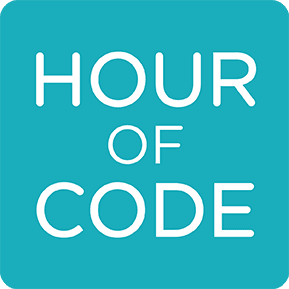The Hour of Code® is an initiative by Code.org to introduce millions of students to one hour of computer science and computer programming.
Teach an AI to Play Pong It's Alive!
Part 4: Training 30 minutes
Now for the fun part. We’re going to create a neural network and train it to know where to move the paddle, given the ball’s current position, direction and speed.
Modules
Neural networks are not part of the core Kid.js framework, so we need to load some additional code. It’s common for JavaScript to be organized this way. Rather than loading everything we could ever possibly use, we can pick and choose only the pieces we need. These pieces are called modules or packages.
Add the following line at the top of your app. This will load the “neural network” module.
import 'neural-network'
Neural Network
We can now create a neural network using the neuralNetwork()
function and store it in a variable. You can use any variable name
you'd like, so give your AI a creative name!
let bob = neuralNetwork()
We’re also going to need to keep track of a few other things. Create a variable called “mode” to keep track of whether our app is in “training” or “autopilot” mode, and a variable called “state”, that will store the ball’s last seen position, speed and direction.
let mode = 'TRAINING'
let state
Let’s display the current mode in the center of the screen so it’s clear to the user.
display(width / 2, height / 2, mode)
Inputs
When the ball bounces off of something, we want to take note of its new position, speed and direction.
We'll create an event handler and connect it to the "collision" event on the ball, similar to what we did with the "move" event earlier. Hopefully you're getting the hang of working with events!
We can store the position, speed and direction together in the
state variable by combining them into an array. An array
is a special type of variable that contains a list of items. Create
an array by listing multiple values separated by commas, inside of
square brackets.
The position, speed and direction will be the inputs to our neural network.
function onBallBounced() {
wait(0.01)
state = [ball.x, ball.y, ball.speed, ball.direction]
}
ball.on('collision', onBallBounced)
Notice we wait a fraction of a second before recording the state. This is to give the ball a chance to change direction after hitting a wall or paddle.
We also want to take note of the ball’s state just after it’s
launched. Modify the launch() function to run
onBallBounced()
function launch() {
ball.x = random(0, width)
ball.y = 70
ball.speed = random(5, 10)
ball.direction = random(45, 135)
onBallBounced()
}
Output
The output of our neural network will be the x coordinate to move the paddle to.
If the ball hits the paddle, that means the paddle was in the right spot. When this happens, we’ll add the state and the paddle’s x position to the training data.
function hit() {
bob.train(state, paddle.x)
}
paddle.on('collision', hit)
Part 5: It's Alive! 30 minutes
Switching to Autopilot
After warming up our AI, we’re ready to hand the reins over. Write a function to change the mode to AUTOPILOT, and run it on the “click” event.
function startAutopilot() {
mode = 'AUTOPILOT'
}
on('click', startAutopilot)
Once the AI is in charge, moving our mouse shouldn’t move the
paddle. Modify the movePaddle() function to only move
the paddle when in training mode. Use an if statement to do this.
function onMouseMove() {
if (mode == 'TRAINING') {
paddle.x = mouseX
}
}
In the onBallBounced() function, we’ll ask the AI where
to move the paddle given its current state. This is where neural
networks are powerful. Even if the network has never seen the ball
in that exact position, speed and direction, it is still able to
make a guess as to where to move the paddle.
Of course we only do this when in AUTOPILOT mode.
function onBallBounced() {
wait(0.01)
state = [ball.x, ball.y, ball.speed, ball.direction]
if (mode == 'AUTOPILOT') {
let x = bob.run(state)
paddle.moveTo(x, paddle.y)
}
}
Try it out. Spend some time training the AI. After 20 hits or so, click to switch over to autopilot.
Human vs Machine
Think you can take on the AI? Let’s add a second paddle, but keep it hidden for the time being.
let human = rect(width / 2, 40, 200, 20)
human.hide()
Update the onMouseMove() function to move this
paddle instead when not in training mode.
We have an existing if statement checking if we
are in training mode. We can build on this by adding a second
block connected with the keyword else. The first
block runs if the condition is true, the second block if the
condition is false.
function onMouseMove() {
if (mode == 'TRAINING') {
paddle.x = mouseX
} else {
human.x = mouseX
}
}
When autopilot starts, show the paddle and reset the score to
zero. Add this to the startAutopilot() function.
function startAutopilot() {
mode = 'AUTOPILOT'
human.show()
hits = 0
misses = 0
}
Game on! May the best intelligence win.
Taking It Further
- Try training the AI for shorter and longer amounts of time. How does that affect how well it performs?
- Increase the speed of the ball after each point. Can the AI keep up? Can you?
- Discuss how you could use neural networks to play other games, or perform certain tasks. What would the inputs and outputs be in each scenario?

When finished, follow the link below, or share it with your students.
I'm finished my Hour of CodeHour of Code® and Hora del Código® are registered trademarks of Code.org